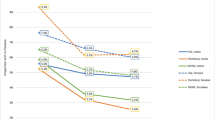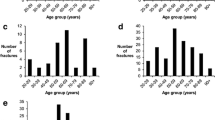Abstract
Background
Fragility fractures of the proximal humerus and distal radius can have a significant impact on the elderly population, both economically and physically. Limited data are available to demonstrate the functional and economic impact of upper extremity fragility fractures.
Aims
To investigate the economic and social impact that proximal humerus fragility fractures may have on an older population.
Methods
A retrospective chart review for patients ≥50 years old treated as an inpatient at a local hospital between 2006 and 2012 for a proximal humerus or a distal radius fracture was done. Patients were divided into two groups to show age impact; Group 1 = 50–79 years old and Group 2 = 80 years and older. Eighty-six charts were reviewed, 38 for Group 1 and 48 for Group 2. Demographic, admission, inpatient, and discharge data were compared between groups.
Results
A third of patients in each group had a previous fragility fracture. Inpatient length of stay was comparable between groups. Surgical treatment was used at a higher rate in the younger cohort (p = 0.06). Approximate average hospital charges for an inpatient surgical treatment were about twice those of the non-surgically treated patients.
Discussion
Our results illustrate the significant burden of upper extremity fractures in terms of loss of independence, inpatient hospitalizations and prolonged nursing home or rehabilitation needs, which account for considerable health care costs.
Conclusion
Fractures of the humerus, forearm and wrist account for one-third of the total incidence of fractures and can be a significant burden to individuals and the community.


Similar content being viewed by others
References
National Osteoporosis Foundation Research Agenda. Available at: http://nof.org/hcp/research/research-agendaAccessed 17 Sep 2013
American Orthopaedic Association—Own the Bone (2011) Osteoporosis epidemic. Retrieved 17 Sept 2013 from http://www.ownthebone.org/about-own-the-bone/osteoporosis-epidemic.aspx
Chrischilles E, Shireman T, Wallace R (1994) Costs and health effects of osteoporotic fractures. Bone 15(4):377–386
Hoerger TJ, Downs KE, Lakshmanan MC et al (1999) Healthcare use among US women aged 45 and older: total costs and costs for selected postmenopausal health risks. J Womens Health Gend Based Med 8(8):1077–1089
Holbrook TL, Grazier KL, AAOS (1984) The frequency of occurrence, impact, and cost of selected musculoskeletal conditions in the United States. American Academy of Orthopaedic Surgeons, Chicago, IL
Phillips S, Fox N, Jacobs J, Wright WE (1988) The direct medical costs of osteoporosis for American women aged 45 and older, 1986. Bone 9(5):271–279
Ray NF, Chan JK, Thamer M, Melton LJ (1997) Medical expenditures for the treatment of osteoporotic fractures in the United States in 1995: report from the National Osteoporosis Foundation. J Bone Miner Res 12(1):24–35
Launonen AP, Lepola V, Flinkkilä T et al (2012) Conservative treatment, plate fixation, or prosthesis for proximal humeral fracture. A prospective randomized study. BMC Musculoskelet Disord 13:167
Calvo E, de Miguel I, de la Cruz JJ, López-Martín N (2007) Percutaneous fixation of displaced proximal humeral fractures: indications based on the correlation between clinical and radiographic results. J Shoulder Elbow Surg 16(6):774–781
Südkamp N, Bayer J, Hepp P et al (2009) Open reduction and internal fixation of proximal humeral fractures with use of the locking proximal humerus plate. Results of a prospective, multicenter, observational study. J Bone Jt Surg Am 91(6):1320–1328
Thanasas C, Kontakis G, Angoules A, Limb D, Giannoudis P (2009) Treatment of proximal humerus fractures with locking plates: a systematic review. J Shoulder Elbow Surg 18(6):837–844
Svedbom A, Ivergård M, Hernlund E, Rizzoli R, Kanis JA (2014) Epidemiology and economic burden of osteoporosis in Switzerland. Arch Osteoporos 9:187
Hernlund E, Svedbom A, Ivergård M et al (2013) Osteoporosis in the European Union: medical management, epidemiology and economic burden. A report prepared in collaboration with the International Osteoporosis Foundation (IOF) and the European Federation of Pharmaceutical Industry Associations (EFPIA). Arch Osteoporos 8(1–2):136
Bleibler F, Rapp K, Jaensch A, Becker C, König HH (2014) Expected lifetime numbers and costs of fractures in postmenopausal women with and without osteoporosis in Germany: a discrete event simulation model. BMC Health Serv Res 14:284
Lee SH, Dargent-Molina P, Bréart G (2002) Study EGEdlO. Risk factors for fractures of the proximal humerus: results from the EPIDOS prospective study. J Bone Miner Res 17(5):817–825
Nguyen TV, Center JR, Sambrook PN, Eisman JA (2001) Risk factors for proximal humerus, forearm, and wrist fractures in elderly men and women: the Dubbo Osteoporosis Epidemiology Study. Am J Epidemiol 153(6):587–595
Seeley DG, Browner WS, Nevitt MC, Genant HK, Scott JC, Cummings SR (1991) Which fractures are associated with low appendicular bone mass in elderly women? The Study of Osteoporotic Fractures Research Group. Ann Intern Med 115(11):837–842
Johnell O, Kanis J (2005) Epidemiology of osteoporotic fractures. Osteoporos Int 16(Suppl 2):S3–S7
Johnell O, Kanis JA, Odén A et al (2004) Mortality after osteoporotic fractures. Osteoporos Int 15(1):38–42
Kanis JA, Oden A, Johnell O, De Laet C, Jonsson B, Oglesby AK (2003) The components of excess mortality after hip fracture. Bone 32(5):468–473
Sernbo I, Johnell O (1993) Consequences of a hip fracture: a prospective study over 1 year. Osteoporos Int 3(3):148–153
Court-Brown CM, McQueen MM (2004) The impacted varus (A2.2) proximal humeral fracture: prediction of outcome and results of nonoperative treatment in 99 patients. Acta Orthop Scand 75(6):736–740
Fjalestad T, Hole M, Jørgensen JJ, Strømsøe K, Kristiansen IS (2010) Health and cost consequences of surgical versus conservative treatment for a comminuted proximal humeral fracture in elderly patients. Injury 41(6):599–605
Grönhagen CM, Abbaszadegan H, Révay SA, Adolphson PY (2007) Medium-term results after primary hemiarthroplasty for comminute proximal humerus fractures: a study of 46 patients followed up for an average of 4.4 years. J Shoulder Elbow Surg 16(6):766–773
Olerud P, Ahrengart L, Söderqvist A, Saving J, Tidermark J (2010) Quality of life and functional outcome after a 2-part proximal humeral fracture: a prospective cohort study on 50 patients treated with a locking plate. J Shoulder Elbow Surg 19(6):814–822
Sanders RJ, Thissen LG, Teepen JC, van Kampen A, Jaarsma RL (2011) Locking plate versus nonsurgical treatment for proximal humeral fractures: better midterm outcome with nonsurgical treatment. J Shoulder Elbow Surg 20(7):1118–1124
Acknowledgments
The authors would like to recognize the contributions made to this study by Jovauna M. Currey, Nathan Kolderman, Surgey Gukasov, and Juan Rango. This study was reviewed and approved by the Bronson Methodist Hospital IRB #BMH-2012-0622.
Conflict of interest
The authors have no conflicts of interest related to this study work.
Author information
Authors and Affiliations
Corresponding author
Appendix: Data collection tool
Appendix: Data collection tool


Rights and permissions
About this article
Cite this article
Sabesan, V.J., Valikodath, T., Childs, A. et al. Economic and social impact of upper extremity fragility fractures in elderly patients. Aging Clin Exp Res 27, 539–546 (2015). https://doi.org/10.1007/s40520-014-0295-y
Received:
Accepted:
Published:
Issue Date:
DOI: https://doi.org/10.1007/s40520-014-0295-y




